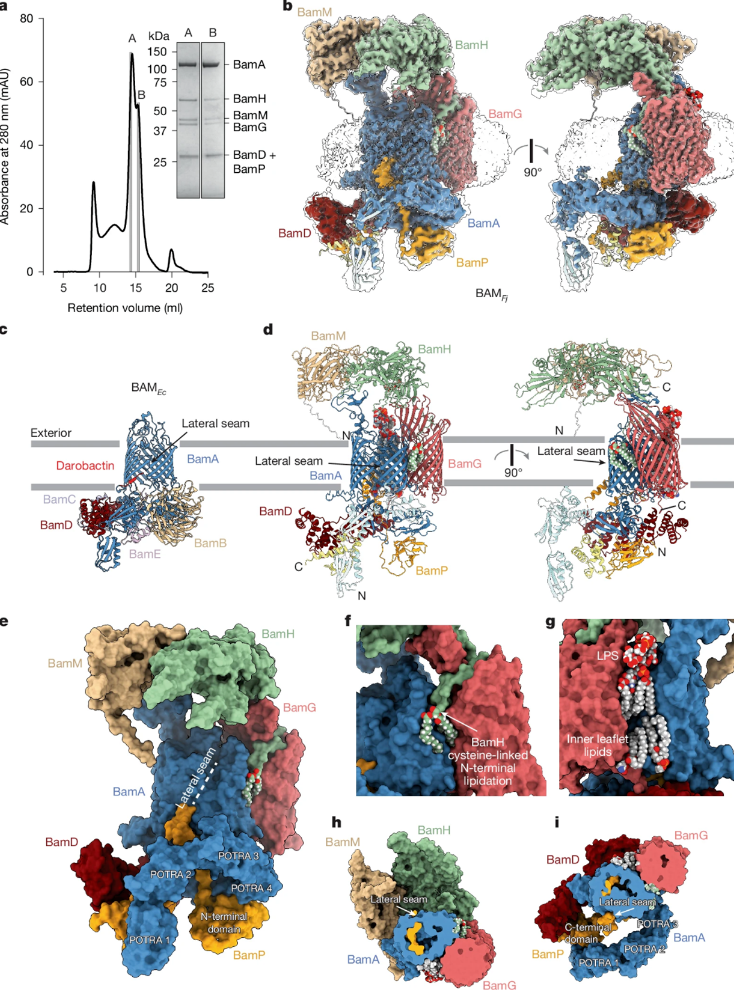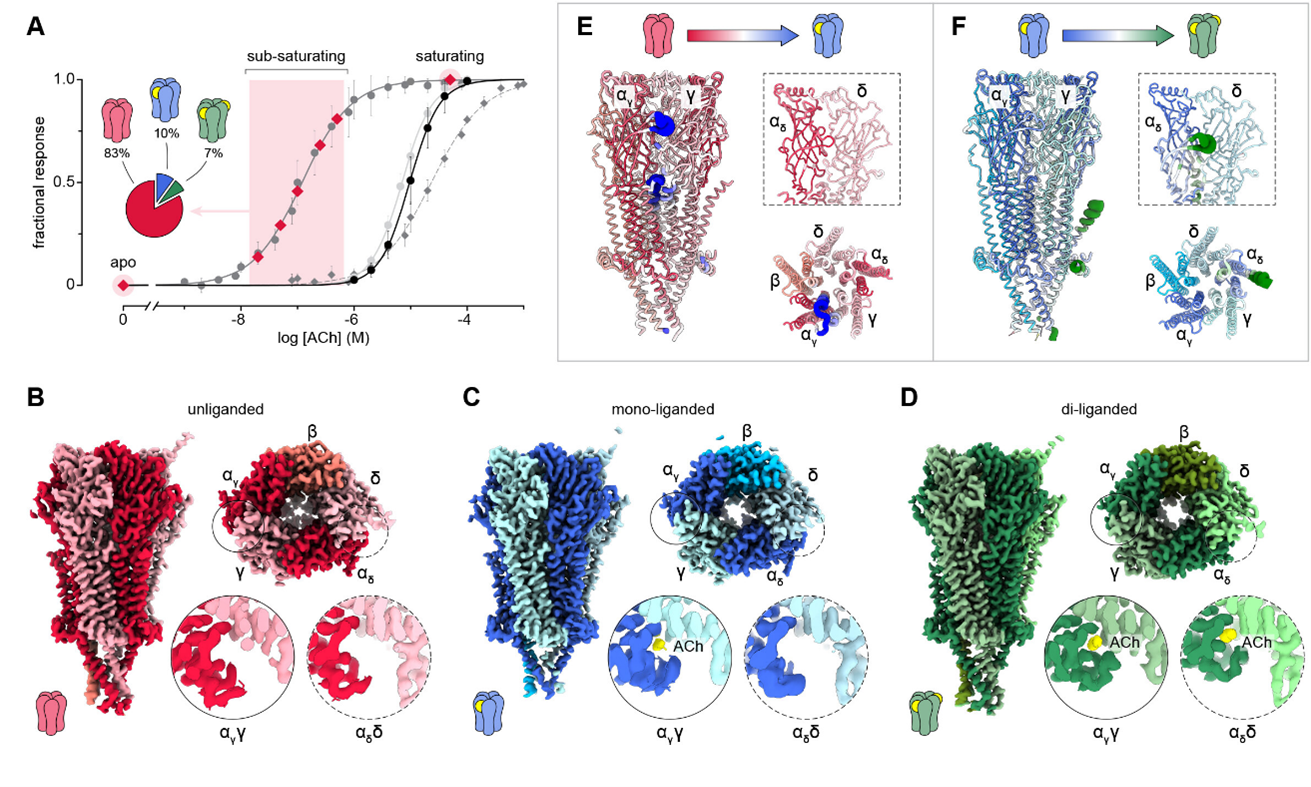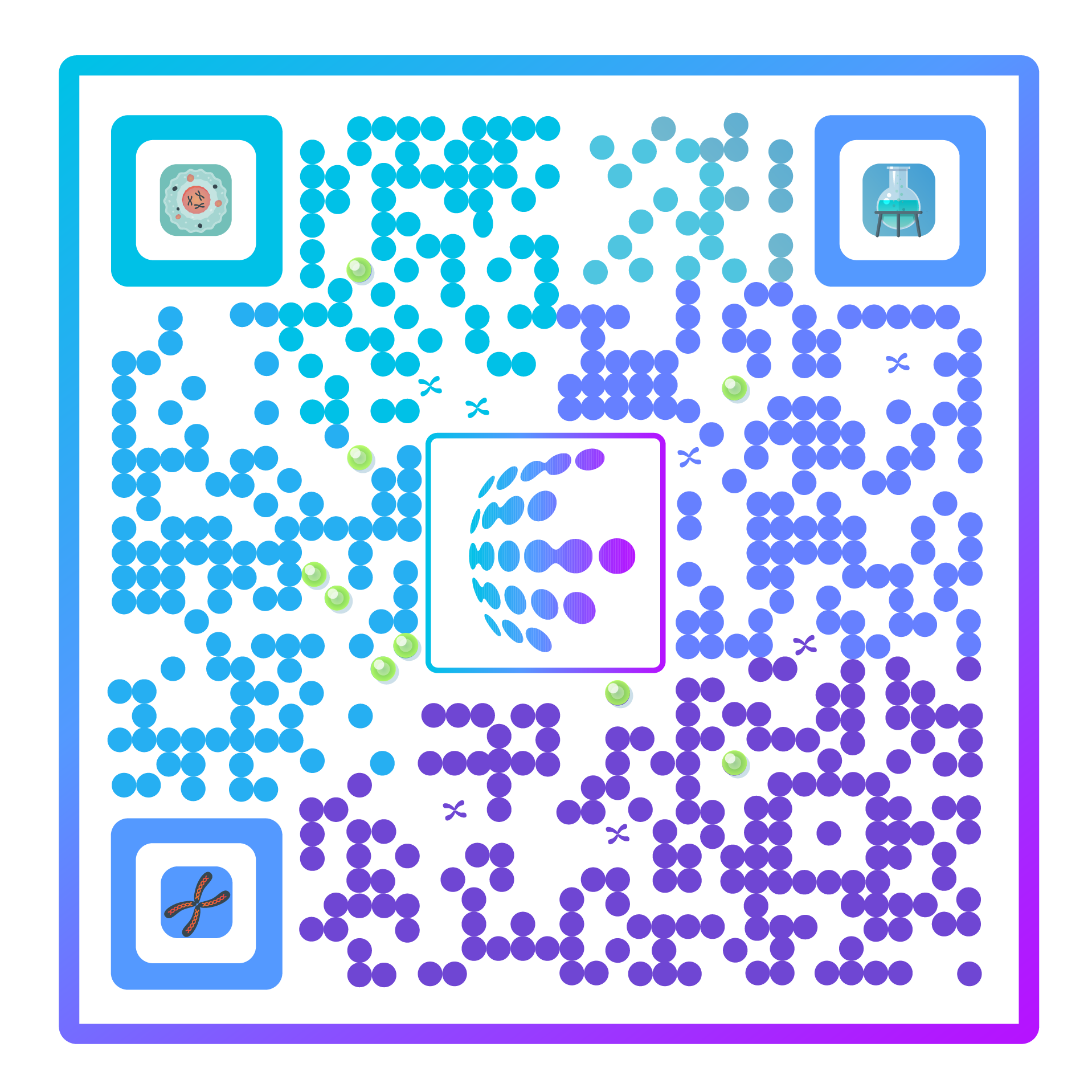2025.09.29~2025.10.05
CNS刊登文章
01
Nature
2025/10/01
“A new paradigm for outer membrane protein biogenesis in the Bacteroidota”

在革兰氏阴性细菌中,外膜是抵御抗菌剂和免疫攻击的第一道防线。外膜生成的关键步骤之一,是通过β-桶组装复合物(β-barrel assembly machinery,BAM) 将外膜蛋白插入外膜中。
来自英国牛津大学的Ben C. Berks和美国国家癌症研究所的Susan M. Lea合作报道了来自 Flavobacterium johnsoniae(约翰逊黄杆菌) 的 BAM 复合物的冷冻电镜结构。该菌属于拟杆菌门(Bacteroidota),这一门包括重要的人体共生菌以及主要的厌氧致病菌。这一 BAM 复合物与典型的 大肠杆菌(Escherichia coli) BAM 系统相比,具有显著的结构改造:它包含一个覆盖在底物折叠位点上的胞外穹顶结构(extracellular canopy),以及一个插入 BAM 孔道中的亚基。新发现的 BamG 和 BamH 亚基参与了该胞外穹顶的形成,它们对 BAM 的功能是必需的,并且在拟杆菌门中高度保守,这表明它们构成了该门细菌中 BAM 核心复合物的关键扩展部分。对于 BamH,通过分离一个抑制突变体(suppressor mutation),研究人员得以区分其必需功能与非必需功能。总体而言,这种高度重塑并增强的 BAM复合物反映了拟杆菌门外膜中存在的结构异常复杂的膜蛋白 所带来的特殊需求。
02
Science
2025/10/02
“Asynchronous subunit transitions prime acetylcholine receptor activation”

突触处的信号传递依赖于突触后受体,这些受体将化学信号转化为电信号。对于配体门控离子通道(ligand-gated ion channels)而言,激动剂(agonist)的结合会触发一系列快速的中间态转变,最终形成短暂开放的离子通道构象,而这些动态变化共同塑造了突触后的电生理响应。
加拿大渥太华大学的John E. Baenziger等团队解析了肌肉型烟碱乙酰胆碱受体(muscle-type nicotinic acetylcholine receptor, nAChR)在无配体结合、单配体结合以及双配体结合状态下的结构。结果显示:当仅有一个激动剂分子结合时,受体整体仍保持闭合状态,但一个主要的激动剂结合亚基会转变为类活化构象(active-like conformation),而另一个未被占据的主要亚基仍保持不活跃,但已处于易于被激活的构象预备状态。将这一中间结构与单通道电生理记录结果结合后,研究揭示了受体按顺序激活(sequential activation)的机制:不同亚基的异步构象转变可使受体逐步进入激活准备状态。此发现不仅深化了对该受体工作原理的理解,也对五聚体配体门控离子通道超家族(pentameric ligand-gated ion channel superfamily)的激活机制具有重要启示意义。
03
Cell
本周无
2025.09.29~2025.10.05
子刊刊登文章
01
Cell Research
10.02
“Secondary structure transitions and dual PIP2 binding define cardiac KCNQ1-KCNE1 channel gating”
02
Molecular Cell
本周无
03
Nature Structural & Molecular Biology
9.29
“Molecular basis for the activation of outer dynein arms in cilia”
04
Nature Communications
9.29
9.29
9.29
3.“Molecular mechanisms of SLC30A10-mediated manganese transport”
9.29
4.“Molecular mechanisms of CBASS phospholipase effector CapV mediated membrane disruption”
9.29
5.“Mechanism for the substrate recognition by a eukaryotic DNA N6-adenine methyltransferase complex”
9.30
6.“Design and evolution of artificial enzyme with in-situ biosynthesized non-canonical amino acid”
9.30
9.30
8.“Calmodulin binding is required for calcium mediated TRPA1 desensitization”
9.30
9.30
10.“CXCR4 mediated recognition of HIV envelope spike and inhibition by CXCL12”
9.30
10.1
12. “Structural insights into Wnt/β-catenin signaling regulation by LGR4, R-spondin, and ZNRF3”
10.01
10.01
14.“The slit diaphragm in Drosophila exhibits a bilayered, fishnet architecture”
10.02
10.02
10.02
17.“Stabilized D2R G protein-coupled receptor oligomers identify multi-state β-arrestin complexes”
10.03
18.“Multi-domain O-GlcNAcase structures reveal allosteric regulatory mechanisms”
10.03
19.“A physiologically-relevant intermediate state structure of a voltage-gated potassium channel”
10.03
20.“The mechanism of thioamide formation by the YcfA-YcfC system in 6-thioguanine biosynthesis”
10.03
10.03
10.03
10.03
05
Science Advances
10.03
1.“The mechanistic basis of cargo selection during Golgi maturation”
10.01
10.03
3.“Cryo-EM resolves the structure of the archaeal dsDNA virus HFTV1 from head to tail”









